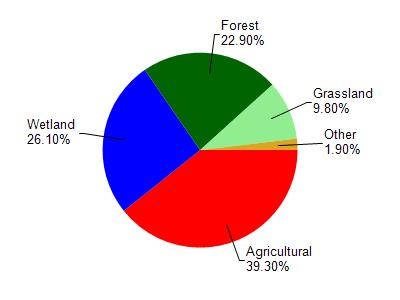Shawano
No
No
No
Fish and Aquatic Life
Overview
Pine Lake (Cloverleaf Chain), in the North Branch and Mainstem Embarrass Rive Watershed, is a 217.13 acre lake that falls in Shawano County. This lake is managed for fishing and swimming and is currently not considered impaired.
Date 2011
Author Aquatic Biologist
Historical Description
Source: 1968, Surface Water Resources of Shawano County Pine Lake, T26N, R15E,Section 34 Surface Acres = 208.6, S.D.F. = 1.04, Maximum Depth = 35 feet.
A hard water drainage lake having slightly alkaline, clear water of moderate transparency. Littoral materials consist of gravel (55 percent), rock (25 percent), sand (10 percent), and muck. The entire shoreline is upland. The assortment of warmwater species inhabiting this lake includes muskellunge, northern pike, largemouth bass, smallmouth bass, perch, bluegill, black crappie, rock bass, pumpkinseed, green sunfish, black bullhead, carp, white sucker, buffalo, long-nose gar, bowfin, burbot, and golden shiner. The lake is considered to have a stunted fish problem. Puddle ducks and diving ducks make use of this lake on their spring and fall migrations. Canada geese and coot also frequent this lake on occasion. A town provides for a very small swimming beach. Public access consists of 2 sites, one with parking and the other without parking as well as the navigable water type as lake is part of the Cloverleaf Chain. Commercial facilities consist of four resorts. There are 134 dwellings located on the shoreline. Water levels are influenced by a water control structure of one head foot located at the outlet. The outlet is tributary to the Embarrass River (Waupaca County).
Date 1968
Author Surface Water Inventory Of Wisconsin
General Condition
Pine Lake (Cloverleaf Chain) (299100) was assessed during the 2016 listing cycle; total phosphorus and chlorophyll sample data were clearly below 2016 WisCALM listing thresholds for the Recreation use and Fish and Aquatic Life use. This water was also assessed for chlorides and sample data were clearly below 2016 WisCALM chronic and acute listing criteria for the Fish and Aquatic Life use. This water is meeting these designated uses and is not considered impaired.
Date 2015
Author Ashley Beranek
Condition
Wisconsin has over 84,000 miles of streams, 15,000 lakes and milllions of acres of wetlands. Assessing the condition of this vast amount of water is challenging. The state's water monitoring program uses a media-based, cross-program approach to analyze water condition. An updated monitoring strategy (2015-2020) is now available. Compliance with Clean Water Act fishable, swimmable standards are located in the Executive Summary of Water Condition in 2018. See also the 'monitoring and projects' tab.
Reports
Recommendations
Best Management Practices, Implement
The Town of Belle Plaine will implement best practices described in Wisconsin's 2014-2017 Healthy Lakes Implementation Plan on the Cloverleaf Lakes. Practices include: fish sticks, 350 ft2 native plantings, and rain gardens on at least 12 properties, including the Gibson Island and Round Lake Park demonstration sites. The best practices require a contract to remain in effect for 10 years and must include minimum operation and maintenance requirements and data collection as described in grant condition #16.
Habitat Restoration - Shoreland
Practices include (across Pine, Round, and Grass Lakes): fish sticks, 350 ft2 native plantings, and rain gardens on at least 12 properties, including the Gibson Island and Round Lake Park demonstration sites.
Management Goals
Wisconsin's Water Quality Standards provide qualitative and quantitative goals for waters that are protective of Fishable, Swimmable conditions [Learn more]. Waters that do not meet water quality standards are considered impaired and restoration actions are planned and carried out until the water is once again fishable and swimmable
Management goals can include creation or implementation of a Total Maximum Daily Load analysis, a Nine Key Element Plan, or other restoration work, education and outreach and more. If specific recommendations exist for this water, they will be displayed below online.
Monitoring
Monitoring the condition of a river, stream, or lake includes gathering physical, chemical, biological, and habitat data. Comprehensive studies often gather all these parameters in great detail, while lighter assessment events will involve sampling physical, chemical and biological data such as macroinvertebrates. Aquatic macroinvertebrates and fish communities integrate watershed or catchment condition, providing great insight into overall ecosystem health. Chemical and habitat parameters tell researchers more about human induced problems including contaminated runoff, point source dischargers, or habitat issues that foster or limit the potential of aquatic communities to thrive in a given area. Wisconsin's Water Monitoring Strategy was recenty updated.
Grants and Management Projects
Monitoring Projects
| WBIC | Official Waterbody Name | Station ID | Station Name | Earliest Fieldwork Date | Latest Fieldwork Date | View Station | View Data |
|---|
| 299100 | Pine Lake | 593043 | Pine Lake - Deep Hole | 2/17/1981 | 10/24/2025 | Map | Data |
| 299100 | Pine Lake | 593175 | Pine Lake - Center of Lake | 5/12/1987 | 5/5/2008 | Map | Data |
| 299100 | Pine Lake | 10005715 | Pine Lake (Shawano Co) | 4/2/1994 | 9/4/2025 | Map | Data |
|

Watershed Characteristics
Pine Lake is located in the North Branch and Mainstem Embarrass Rive watershed which is 312.62 mi². Land use in the watershed is primarily agricultural (39.30%), wetland (26.10%) and a mix of forest (22.90%) and other uses (11.70%). This watershed has 488.32 stream miles, 1,175.84 lake acres and 51,339.03 wetland acres.
Nonpoint Source Characteristics
This watershed is ranked High for runoff impacts on streams, High for runoff impacts on lakes and High for runoff impacts on groundwater and therefore has an overall rank of High. This value can be used in ranking the watershed or individual waterbodies for grant funding under state and county programs.However, all waters are affected by diffuse pollutant sources regardless of initial water quality. Applications for specific runoff projects under state or county grant programs may be pursued. For more information, go to surface water program grants.